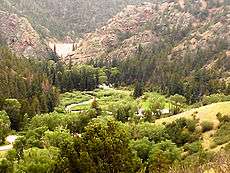Cimarron River (Canadian River)
| Cimarron River[1] | |
|---|---|
|
A view of the Cimarron River as it leaves Eagle Nest Dam | |
| Basin | |
| Main source |
8,146 ft (2,483 m) 36°31′49″N 105°13′41″W / 36.53028°N 105.22806°W |
| River mouth |
Confluence with Canadian 5,679 ft (1,731 m) 36°19′27″N 104°29′58″W / 36.32417°N 104.49944°WCoordinates: 36°19′27″N 104°29′58″W / 36.32417°N 104.49944°W |
| Progression | Canadian—Arkansas—Mississippi |
| Physical characteristics | |
| Length | 60 mi (97 km) |
The Cimarron River, flowing entirely in New Mexico, was originally known as the Le Flecha. It runs for 60 miles (97 km) from Eagle Nest Dam to below the city of Springer, New Mexico, and is a tributary of the Canadian River, the southwesternmost major tributary flowing into the Mississippi River via the Arkansas River sub-basin. The river begins within a mountainous canyon that is part of Cimarron Canyon State Park in the lower Sangre de Cristo Mountains and runs down into eastern plains of New Mexico. The region is also home to the well known Philmont Scout Ranch.
Irrigation
The Cimarron River is primarily used to convey runoff water from the Moreno Valley, to local farmers and ranchers downstream who have water rights from Eagle Nest Lake. There are several diversion points along the river in which water is moved into canals and ditches. Some irrigation water travels more than 50 miles downstream to locations where it is to be used.
Fishing
The first dozen miles of the Cimarron River (from Eagle Nest Lake to Ute Park, New Mexico) are known for fine trout fishing. Stocked trout include rainbow and brown. The river is maintained by the New Mexico Department of Game and Fish at a trout density of approximately 3,000 fish per mile, although water flow can vary between 2 and 50 cfs.[2] Fishing season is busiest during the summer months.
Camping
Cimarron Canyon State Park is home to three full campgrounds, which are located along the river between the towns of Eagle Nest and Cimarron. These include the Maverick, Tolby, and Ponderosa sites. All three campgrounds offer numerous individual sites for RV or tent camping. Full bathrooms with plumbing (and potable water) are available at each site, although electricity is not. Campfires are allowed at the discretion of the county fire marshal, in combination of the local park rangers. Normal camping season takes place between the middle of May to mid September.
Climate
| Climate data for Cimarron | |||||||||||||
|---|---|---|---|---|---|---|---|---|---|---|---|---|---|
| Month | Jan | Feb | Mar | Apr | May | Jun | Jul | Aug | Sep | Oct | Nov | Dec | Year |
| Average high °F (°C) | 47 (8) |
51 (11) |
56 (13) |
63 (17) |
72 (22) |
81 (27) |
84 (29) |
81 (27) |
77 (25) |
68 (20) |
55 (13) |
49 (9) |
65.3 (18.4) |
| Average low °F (°C) | 16 (−9) |
19 (−7) |
25 (−4) |
31 (−1) |
39 (4) |
48 (9) |
52 (11) |
51 (11) |
44 (7) |
33 (1) |
23 (−5) |
17 (−8) |
33.2 (0.8) |
| Average precipitation inches (mm) | 0.3 (8) |
0.3 (8) |
0.6 (15) |
1.7 (43) |
2.3 (58) |
1.4 (36) |
3.3 (84) |
2.6 (66) |
0.9 (23) |
1.1 (28) |
0.5 (13) |
0.4 (10) |
15.5 (394) |
| Source: [3] | |||||||||||||

Wildlife
The most common wildlife to frequent the region include deer, beavers, mice, squirrels, rabbits, chipmunks, and swallows. Mountain lions, coyotes, and black bears are occasionally spotted as well.[4]
See also
- List of rivers of New Mexico
- Canadian River
- Cimarron, New Mexico
- Cimarron Canyon State Park
- Eagle Nest, New Mexico
- Eagle Nest Dam
- Philmont Scout Ranch
- Springer, New Mexico
References
- ↑ "Cimarron River". Geographic Names Information System. United States Geological Survey. Retrieved 2 April 2011.
- ↑ "Cimarron River Fly Fishing in New Mexico". Ed Adams. Retrieved 28 July 2013.
- ↑ "Cimarron, New Mexico". Weatherbase. Retrieved 28 July 2013.
- ↑ "Environmental Science Field Guide to New Mexico". Anita SdeArmijo. Retrieved 28 July 2013.
